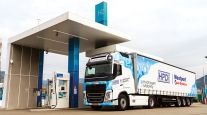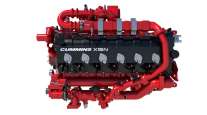Infrastructure, Maintenance Among Issues Preventing Faster Transition to Natural Gas
This story appears in the Dec. 10 print edition of Transport Topics.
ARLINGTON, Va. — The low price of natural gas is a main reason why it is so appealing to trucking, but concerns ranging from infrastructure to maintenance are forcing the industry to go slow, executives said.
Additional speakers at American Trucking Associations’ Summit on Natural Gas in Trucking here also raised some environmental and safety issues that need to be resolved before widespread acceptance takes place.
Truckers said that with natural gas priced as much as $2 a gallon-equivalent cheaper than diesel, it is an attractive option.
And U.S. natural gas prices are expected to remain significantly lower than diesel — which has languished at $4 a gallon — primarily because of the plentiful domestic gas supply.
With that kind of savings, executives with UPS Inc., Swift Transportation and Lynden Inc. each said they have no choice but to consider expanding fuel options to include natural gas.
“We’re spending hundreds of millions a year for fuel, so that was a serious problem,” said Jim Bruce, vice president of corporate public affairs for UPS, Atlanta.
Kara Ross, a spokeswoman for the package carrier, said UPS spent $4 billion on fuel across all segments last year and, so far this year, has shelled out $3 billion.
UPS has a great deal of experience, given the 1,424 alternative-fuel vehicles in its U.S. fleet. As early as 1989, it was using compressed natural gas vehicles and by 2000 had added liquefied natural gas vehicles. Overall, it currently has 933 CNG vehicles and 93 LNG.
For longhaul trucking operations, the company prefers LNG, Bruce said.
LNG is made by chilling natural gas to at least minus 260 degrees Fahrenheit; it is thought of as the choice form for heavy-duty trucks making longer hauls.
“There are CNG options for Class 8 if you can stack the cylinders on the back, and we’re looking at that,” Bruce added.
While Jerry Moyes, chairman and CEO of Swift, Phoenix, agrees natural gas improves overall cost efficiencies, he is not completely sold on the overall value.
“We’re being asked to pay $100,000 extra for these trucks,” he said, noting that the reduced torque and fairly common engine technology doesn’t justify the cost, especially considering how frequently Swift turns over its fleet.
“We run 16,000 trucks and trade them every four years. We’ve got to know what the resale value is. It’s a big unknown,” he said.
Poor infrastructure is another apprehension for executives.
Throughout the conference, the lack of refueling options on long-distance routes was emphasized — which could drastically cut operating range — as well as the cost of installation, which can range from $1 million for a simple auto-fill station to $10 million for an eight-lane CNG station, by some estimates.
Lynden, Anchorage, Alaska, is yet to try natural gas in its trucks, but Anna Deal, head of the company’s green initiatives, said it is an attractive possibility, citing that it is a cleaner-burning fuel.
In a project between Lynden and the National Energy Policy Institute, Tulsa, Okla., Lynden found such pros as a minimum of about 70,000 miles per truck per year would yield a 20% return on investment and barriers that included the additional weight of fuel tanks that detract from payload and revenue.
“The question is: When do the savings from the less-expensive natural gas outweigh all of the disadvantages?” Deal asked.
Separately, Fred Krupp, president of the Environmental Defense Fund, agreed that “natural gas could be the opportunity we’re all looking for, but there are some big questions that need to be addressed first.”
In particular, he said a lack of adequate data about the amount of greenhouse-gas leakage from wells and pipelines during natural-gas production makes the large investment needed for motor carriers to retool their fleets a “high-risk proposition.”
Those methane escapes should be limited to less than 1% of the natural gas produced, Krupp said.
“Until we have assurance that we’re at 1%, or can see a clear way that we’re going to be there soon, we can’t endorse moving forward with natural gas,” Krupp said.
“None of us want to go down an expensive ride on a dead-end street.”
In addition to environmental concerns, there also are potential safety issues, said David Hill, vice president of natural gas economy operations for Encana Corp., a Canadian natural gas producer.
Training of drivers for handling natural gas fuels is essential, Hill said. Natural gas is potentially flammable when spilled, but harder to ignite. However, because it is odorless, the primary danger is asphyxiation, Hill said. And, Hill said no flip-flops for drivers — it will burn or freeze the skin on contact.




